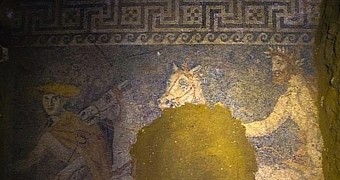For quite a while now, a team of archaeologists in Greece have been pretty busy excavating a tomb located in Amphipolis, a municipality in the country's Serres regional unit. The tomb is estimated to date back to the 4th century BC, and comprises several chambers.
This past Sunday, the Greek Ministry of Culture went public with the news that, having worked their way into the tomb's second chamber, whose entrance was guarded by two gorgeous female sculptures, researchers came face to face with a stunning mosaic.
One of the most beautiful ancient mosaics
Information shared with the public says that the mosaic covers the floor of the tomb's second chamber in its entirety. Archaeologists have until now uncovered a fragment measuring 4.5 meters (14.7 feet) in width and 3 meters (9.8 feet) in length.
As detailed by the Greek Reporter, this mosaic fragment that specialists have thus far unearthed and studied indicates that the artwork shows a chariot in motion.
The chariot appears to be pulled by two white horses and driven by Hermes, messenger of the gods and conductor of souls.
This scene is surrounded by a decorative frame showing geometrical patters. Like the floor mosaic per se, this decorative frame was created by putting together pebbles of different colors. Archaeologists have until now identified white, grey, black, red, blue and yellow pebbles.
As noticeable in the photo accompanying this article, the mosaic is not exactly in good condition. Thus, it appears that, decades ago, its center somehow ended up being badly damaged.
The good news is that the pebbles missing from this area are scattered all over the floor, which means that archaeologists might be able to put the mosaic back together.
Whose tomb it is anyways?
As mentioned, the tomb and the artwork inside it date back to the 4th century BC. More precisely, specialists say that the actual tomb, the sculptures and the mosaics inside it were put together sometime between 325 BC and 300 BC.
Hence, it is believed that the tomb was created to accommodate for the remains of somebody very close to ancient ruler Alexander the Great. Some say that it served as a burial place for Alexander's mother. Others are quite convinced that it was built for one of the ruler's generals.
The thing is that, since this tomb was first discovered back in August until now, archaeologists have failed to uncover any human remains at this site in northern Greece. Then again, they are yet to explore the tomb in its entirety, so maybe it's only a matter of time until they come across the skeleton of the person for whom this tomb was built.

 14 DAY TRIAL //
14 DAY TRIAL //